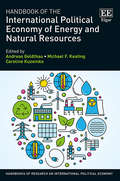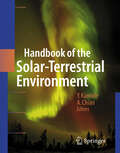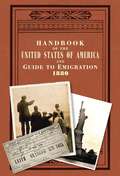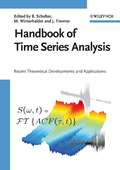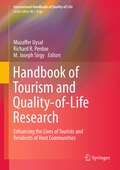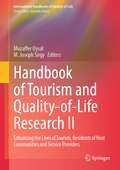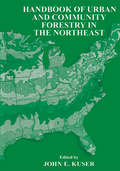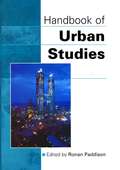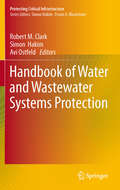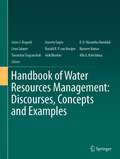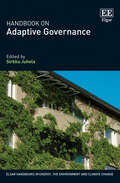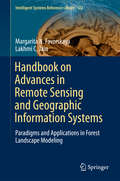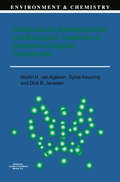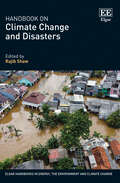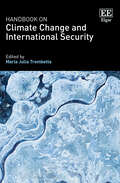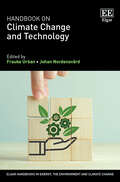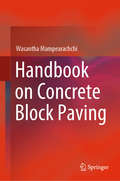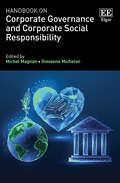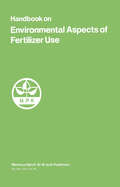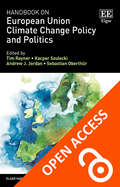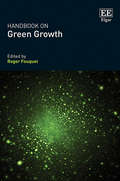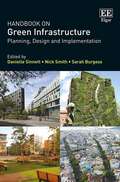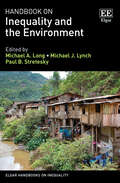- Table View
- List View
Handbook of the International Political Economy of Energy and Natural Resources (Handbooks of Research on International Political Economy series)
by Caroline Kuzemko Andreas Goldthau Michael F. KeatingThis Handbook offers a comprehensive overview of the latest research from leading scholars on the international political economy of energy and resources. Highlighting the important conceptual and empirical themes, the chapters study all levels of governance, from global to local, and explore the wide range of issues emerging in a changing political and economic environment. The original contributions analyse energy as a highly complex, interconnected policy area, including how energy markets and regimes are constituted and the governance institutions that are being designed to challenge existing establishments. A number of contributors focus on intersections between energy and other policy fields or sectors, or nexes. These include the climate change, energy and low carbon transitions nexus; the food, water and forestry nexus; the energy, resources and development nexus; and the global–national–local nexus in energy. Significantly, this Handbook ties the contributions together by exploring opportunities for sustainable transitions and avoiding resource scarcity whilst taking other social needs, such as development, into account. This Handbook will be an essential resource for scholars and students of international political economy, governance and development studies as it covers: the environment, development, human rights, global production, energy transitions and energy security.
Handbook of the Solar-Terrestrial Environment
by Yohsuke Kamide Abraham C. L ChianAs a star in the universe, the Sun is constantly releas- cover a wide range of time and spatial scales, making ?? ing energy into space, as much as ?. ? ?? erg/s. Tis observations in the solar-terrestrial environment c- energy emission basically consists of three modes. Te plicated and the understanding of processes di?cult. ?rst mode of solar energy is the so-called blackbody ra- In the early days, the phenomena in each plasma diation, commonly known as sunlight, and the second region were studied separately, but with the progress mode of solar electromagnetic emission, such as X rays of research, we realized the importance of treating and UV radiation, is mostly absorbed above the Earth’s the whole chain of processes as an entity because of stratosphere. Te third mode of solar energy emission is strong interactions between various regions within in the form of particles having a wide range of energies the solar-terrestrial system. On the basis of extensive from less than ? keV to more than ? GeV. It is convenient satellite observations and computer simulations over to group these particles into lower-energy particles and thepasttwo decades, it hasbecomepossibleto analyze higher-energy particles, which are referred to as the so- speci?cally the close coupling of di?erent regions in the lar wind and solar cosmic rays, respectively. solar-terrestrial environment.
Handbook of the United States of America, 1880: A Guide to Emigration
by Lp BrockettMillions of immigrants entered America's "golden door†? in the years after 1880. This authentically reproduced Handbook of the United States was a trusted resource that told them everything they needed to know as they strove to become Americans. America's "golden door†? welcomed a huge wave of European immigrants between the 1880s and the 1920s. Millions passed through the gateway of the Statue of Liberty and Ellis Island on their way to becoming Americans, and The Handbook of the United States is an authentic reproduction of one of the immigrants' most trusted resources- a complete guide to the USA, including everything from the pay-rates of various trades to amusing statistics about what Americans ate, drank, and manufactured. Once the tool that helped thousands of Irish, Italian and Jewish immigrants use their drive and industriousness to succeed, today it provides new insights into the extraordinary circumstances of the immigrant experience and the new arrivals' remarkable contribution to making America a great global power.
Handbook of Time Series Analysis: Recent Theoretical Developments and Applications
by Bjö Schelter Matthias Winterhalder Jens TimmerThis handbook provides an up-to-date survey of current research topics and applications of time series analysis methods written by leading experts in their fields. It covers recent developments in univariate as well as bivariate and multivariate time series analysis techniques ranging from physics' to life sciences' applications. Each chapter comprises both methodological aspects and applications to real world complex systems, such as the human brain or Earth's climate. Covering an exceptionally broad spectrum of topics, beginners, experts and practitioners who seek to understand the latest developments will profit from this handbook.
Handbook of Tourism and Quality-of-Life Research: Enhancing the Lives of Tourists and Residents of Host Communities (International Handbooks of Quality-of-Life)
by Muzaffer Uysal, Richard Perdue and M. Joseph SirgyQuality of life (QOL) research in tourism has gained much momentum over the last two decades. Academics working in this area research issues related to tourists and host communities. Practitioners are becoming increasingly interested in understanding the science that allows them to develop better marketing and managerial programs designed to enhance the quality of life of tourists. Tourism bureaus and government agencies are increasingly interested in issues of sustainable tourism, specifically in understanding and measuring the impact of tourism on the quality of life of the residents of the host communities. This handbook covers all relevant topics and is divided into two parts: research relating to travelers/tourists, and research relating to the residents of host communities. It is the only state-of-the-art reference book in its field and will prove invaluable to academics interested in QOL research, as well as tourism practitioners interested in applying the science of QOL in the tourism industry.
Handbook of Tourism and Quality-of-Life Research II: Enhancing the Lives of Tourists, Residents of Host Communities and Service Providers (International Handbooks of Quality-of-Life)
by Muzaffer Uysal M. Joseph SirgyThe second volume of this handbook develops on and extends the discussion in the successful first volume, published in 2012. This is a timely addition to the literature, drawing on the momentum that quality of life (QOL) research in tourism has gained in the 21st century and on the boom in the tourism industry itself. It focuses on four areas of growth in QOL research in the recent past: (1) travelers/tourists, (2) host communities, (3) service providers, and (4) the role of technology. The handbook helps management of tourism firms and policy makers develop specific policies and programs to ensure the most positive impact of tourism on tourists, host communities, and service providers. The comprehensive coverage of topics in this handbook makes it a state-of-the-art reference. Academics interested in QOL research in travel and tourism, tourism practitioners interested in applying the science of QOL in the tourism industry, as well as policy makers involved in regulating the industry will view the handbook as indispensable source of recent research.
Handbook of Urban and Community Forestry in the Northeast
by John E. KuserWith the emergence of urban and community forestry as the fastest growing part of our pro fession in the last 15 years, the need for a book such as this inevitably developed. The So ciety of American Foresters' urban forestry working group counts 32 or more universities now offering courses in this subject, and the number is growing. For the last several years I have coordinated a continuing education urban forestry course at Rutgers for nonmatriculated students. Registrants have included arborists, shade tree commissioners, landscape architects, city foresters, environmental commissioners, park superintendents, and others whose jobs involve care and management of trees. The course was started by Bob Tate in 1980, around a core of managerial subjects such as in ventories, budgets, and public relations. After Bob left in 1984 to join Asplundh and later to start his own prosperous business in California, the course languished after it exhausted the local market for those subjects.
Handbook of Urban Studies (PDF)
by Ronan PaddisonThe Handbook of Urban Studies provides the first comprehensive, up-to-date account of the urban condition, relevant to a wide readership from academics to researchers and policymakers. It provides a theoretically and empirically informed account embracing all the different disciplines contributing to urban studies. Leading authors identify key issues and questions and future trends for further research and present their findings so that, where appropriate, they are relevant to the needs of policymakers. Using the city as a unifying structure, the Handbook provides an holistic appreciation of urban structure and change, and of the theories by which we understand the structure, development and changing character of cities.
Handbook of Water and Wastewater Systems Protection (Protecting Critical Infrastructure)
by Robert M. M. Clark, Simon Hakim and Avi OstfeldFollowing the events of 9/11, the Administrator of the US Environmental Protection Agency created the Water Protection Task Force (WPTF), which identified water and wastewater systems as a major area of vulnerability to deliberate attack. The WPTF suggested that there are steps that can be taken to reduce these vulnerabilities and to make it as difficult as possible for potential saboteurs to succeed. The WPTF recommended that be scrutinized with renewed vigor to secure water and wastewater systems against these possible threats. It also recommended that water and wastewater systems have a response plan in place in the event an act of terrorism occurs. The WPTF identified water distribution networks as an area of special vulnerability and highlighted the need for rapid on-line detection methods that are accurate and have a wide detection range. As a result of these recommendations novel technologies from various fields of science and engineering are now addressing water security issues and water and wastewater utilities are looking for innovative solutions. Once such technologies are available, there will be a rapid implementation process that will present many business opportunities for the private sector. However, in addition to terrorist threats water and wastewater systems are inherently vulnerable to natural disasters such as earthquakes and floods. This volume will address the problems associated with both intended terrorist attacks and natural disasters affecting water or wastewater systems. The book is divided into parts based on the kinds of threats facing water and wastewater systems: (1) a direct attack on water and wastewater infrastructure storage reservoirs, and distribution and collection networks; (2) a cyber attack disabling the functionality of the water and wastewater systems or taking over control of key components which might result in system failures; and (3) a deliberate chemical or biological contaminant injection at one of the water distribution system’s nodes. It will examine unique plans, technological and managerial innovations for protecting such systems, and includes descriptions of projects that were implemented to respond to natural disasters. Case studies are presented that discuss existing projects and evaluate their performance, with an emphasis on providing guidelines and techniques that can be implemented by water and wastewater planners and managers to deal with natural and manmade disasters should they occur.
Handbook of Water Resources Management: Discourses, Concepts and Examples
by Janos J. Bogardi Joyeeta Gupta K. D. Wasantha Nandalal Léna Salamé Ronald R. P. van Nooijen Navneet Kumar Tawatchai Tingsanchali Anik Bhaduri Alla G. KolechkinaThis book provides an overview of facts, theories and methods from hydrology, geology, geophysics, law, ethics, economics, ecology, engineering, sociology, diplomacy and many other disciplines with relevance for concepts and practice of water resources management. It provides comprehensive, but also critical reading material for all communities involved in the ongoing water discourses and debates.The book refers to case studies in the form of boxes, sections, or as entire chapters. They illustrate success stories, but also lessons to be remembered, to avoid repeating the same mistakes. Based on consolidated state-of-the-art knowledge, it has been conceived and written to attract a multidisciplinary audience.The aim of this handbook is to facilitate understanding between the participants of the international water discourse and multi-level decision making processes. Knowing more about water, but also about concepts, methods and aspirations of different professional, disciplinary communities and stakeholders professionalizes the debate and enhances the decision making.
Handbook of World Salt Resources (Monographs in Geoscience)
by Stanley J. LefondSixty years ago the Louisiana Geological Survey published "Rock Salt. Its Origin. Geological Occurrences and Economic Importance in the' State of Louisiana, Together with Brief Notes and References to All Known Salt Deposits and Industries of the World" (Bull., 7, 1908, 259 pp.) by G. D. Harris, assisted by G. D. Maury and L. Reineke. The volume which follows is an equally ambitious project, carved out as a labor of love by Stanley J. Lefond, who began the work when he was a geologist with Diamond Alkali Company, Cleve land, Ohio, and finished it when he was a member of the geology staff of United States Borax & Chemical Corp., Los Angeles. Mr. Lefond has done a thorough job, taking full advantage of the discoveries (due in large part to exploration of the subsurface in the search for oil), expanded governmental coverage of mineral deposits, and improved communications, since 1908. The motivation for "The Handbook of World Salt Resources" was the First Symposium on Salt, held in Cleveland in May, 1962, which was sponsored and organized by the relatively young and dynamic Northern Ohio Geological Society. The user of this valuable compilation owes a debt of gratitude to that Society, to the Diamond Alkali Company which donated countless hours of Mr. Lefond's time, and above all, to author Stanley Lefond.
Handbook on Adaptive Governance (Elgar Handbooks in Energy, the Environment and Climate Change)
The interconnectedness of global society is increasingly visible through crises such as the current global health pandemic, emerging climate change impacts and increasing erosion of biodiversity. This timely Handbook navigates the challenges of adaptive governance in these complex contexts, stressing the necessarily compounded nature of biophysical and social systems to ensure more desirable governance outcomes.Highlighting the dynamics and diversity of governance systems across the globe, leading experts in the field examine the successes and failures of these systems. Synthesising theory with methodology and practical case studies, chapters explore adaptive governance in forest management, marine environments and open data ecosystems, looking closely at the role of adaptive governance in climate mitigation and disaster risk reduction. Answering the call for large-scale transformations that move societies away from unsustainable development trajectories, this prescriptive Handbook explores the existing adaptive governance measures that have driven reflexive, sustainable change. Reflecting on the past decade of research in the field, it concludes by outlining new areas of contention and inquiry for the next decade of adaptive governance research.Interdisciplinary in scope, this comprehensive Handbook will prove an invigorating read for students and scholars of environmental law, governance and regulation, and political science and public policy. Policymakers looking to innovate their adaptive governance approaches will also find this a beneficial companion.
Handbook on Advances in Remote Sensing and Geographic Information Systems: Paradigms and Applications in Forest Landscape Modeling (Intelligent Systems Reference Library #122)
by Margarita N. Favorskaya Lakhmi C. JainThis book presents the latest advances in remote-sensing and geographic information systems and applications. It is divided into four parts, focusing on Airborne Light Detection and Ranging (LiDAR) and Optical Measurements of Forests; Individual Tree Modelling; Landscape Scene Modelling; and Forest Eco-system Modelling. Given the scope of its coverage, the book offers a valuable resource for students, researchers, practitioners, and educators interested in remote sensing and geographic information systems and applications.
Handbook on Biodegradation and Biological Treatment of Hazardous Organic Compounds (Environment & Chemistry #2)
by M.H. van Agteren Sytze Keuning D. JanssenThe introduction of synthetic organic chemicals into the environment during the last few decades has given rise to major concern about the ecotoxicological effects and ultimate fate of these compounds. The pollutants that are considered to be most hazardous because of their intrinsic toxicity, high exposure level, or recalcitrant behavior in the environment have been placed on blacklists and other policy priority lists. The fate of synthetic compounds that enter the environment is mainly determined by their rate of biodegradation, which therefore also has a major effect on the degree of bioaccumulation and the risk of ecotoxicological effects. The degree and rate of biodegradation is also of critical importance for the feasibility of biological techniques to clean up contaminated sites and waste streams. The biodegradation of xenobiotics has thus been the subject of numerous studies, which resulted in thousands of publications in scientific journals, books, and conference proceedings. These studies led to a deeper understanding of the diversity of biodegradation processes. As a result, it has become possible to enhance the rate of degradation of recalcitrant pollutants during biological treatment and to design completely new treatment processes. At present, much work is being done to expand the range of pollutants to which biodegradation can be applied, and to make treatment techniques less expensive and better applicable for waste streams which are difficult to handle.
Handbook on Climate Change and Disasters (Elgar Handbooks in Energy, the Environment and Climate Change)
This comprehensive Handbook assesses the escalation of global natural disasters as a result of climate change. Examining the complex interplay of human and natural activities, it highlights the growing vulnerability of people and communities in developing countries to floods, landslides, cyclones, heat waves and wildfires. The Handbook opens with a global framework analysis, outlining the implications of the UN Sustainable Development Goals, the Paris Agreement and the Sendai Framework for disaster risk reduction. International contributors address the roles of stakeholders in mitigating climate hazards, as well as offer detailed analysis of cross-cutting issues, including poverty, health, education and gender. Concluding chapters address the future of climate change mitigation and disaster protection, exploring the growing role of emerging technologies in disaster resilience and sustainable development. Bringing together cutting-edge research from renowned global scholars and professionals, this Handbook offers key insights for researchers and students of environmental studies and development studies, particularly those focusing on natural disasters and climate technologies. The empirical data and case analysis will also benefit practitioners, professionals and policymakers working in climate risk relief.
Handbook on Climate Change and International Security
This topical Handbook explores the emergence of climate change as an international security issue, the threats it poses, and the political and academic debates it has prompted. Framing climate change as a security issue, it explores the ways relevant actors, states and international organizations have conceptualized climate security and its associated threats.Theoretically sound and empirically innovative, this Handbook explores the political implications of linking climate change and security and tackles the questions that are subsequently raised. Through a collection of international case studies, expert contributors explore a diverse range of issues emerging in the debate about climate change and security, including the problem of migration, the impact on energy security and the role of the military. Contributing to various discourses, logics, practices and constructions of climate security, the Handbook outlines how security language shapes and transforms the way climate change is governed. Ultimately, it identifies an emerging, broader reconceptualization of international security in the Anthropocene.Displaying the challenges that climate change poses in the context of existing security practices and institutions, this Handbook will be vital for policymakers looking to identify and understand threats to formulate effective countermeasures. It will also prove useful to students and scholars of security studies, international relations, climate change and energy politics, environmental politics and policy, and governance.
Handbook on Climate Change and Technology (Elgar Handbooks in Energy, the Environment and Climate Change)
This timely Handbook presents the latest knowledge on technological innovation for climate change mitigation and adaptation. Looking beyond technical fixes, it further draws on economics, politics and sociology to explore how modern technology can contribute to effective and socially just sustainability transitions.Examining cutting-edge research on energy, transport and industry, this Handbook argues that we have the technologies and policy instruments needed to mitigate and adapt to climate change. However, for larger-scale implementation the support at the socio-economic and political levels has to be increased. Chapters further analyse the role that technology plays in key sectors, such as agriculture and forestry, in order to become more sustainable. Contributors also reflect on the position of technology in society, illustrating the wider socio-technical systems that determine the impact that new technologies can have. They call for the political will to implement and scale up technological measures to address climate change across the world.The Handbook on Climate Change and Technology will be essential reading for academics and students of climate change, energy, sustainability and environmental governance and regulation. It will also be an invaluable resource for practitioners and policymakers seeking a deeper understanding of the role of technology in sustainability transitions.
Handbook on Concrete Block Paving
by Wasantha MampearachchiThis book provides a comprehensive overview of concrete block paving (CBP). Starting with the basics, such as the history, applications, advantages and limitations of CBP, it then discusses in detail the structural behavior, construction process, and design support conditions, covering topics like specifications for blocks and laying patterns, field performance and mix design for ICBP. Lastly, it examines good CBP practices and maintenance.
Handbook on Corporate Governance and Corporate Social Responsibility
The world-wide transition towards corporate social responsibility (CSR) results in profound changes to business practices. Hence, this crucial Handbook adopts a global perspective to review key CSR issues and their implications for the future evolution of corporate governance.Michel Magnan and Giovanna Michelon bring together leading experts who deftly explore the critical tensions and areas of convergence between CSR and corporate governance. The Handbook further assesses the environmental responsibilities corporations are now facing and examines the wide range of social responsibility issues affecting businesses, with a particular focus on corporate philanthropy, boardroom diversity, workplace harassment and gender equality. The Handbook concludes with some thought-provoking discussion about the future evolution of corporate governance if it is to succeed in addressing emerging environmental and social challenges. Arguing that environmental and social responsibilities represent the essence of CSR, this dynamic Handbook provides a number of policy and practical recommendations, proposing ideas for future research and useful indications for boards of directors.This incisive and forward-thinking Handbook will be an important read for academics and researchers interested in corporate governance, CSR, and sustainability. It will also prove highly beneficial for professionals and practitioners working in corporate governance and its intersection with sustainability.
Handbook on Environmental Aspects of Fertilizer Use
by International Potash International Potash Institute (IPI)Handbook on European Union Climate Change Policy and Politics (Elgar Handbooks in Energy, the Environment and Climate Change)
The Handbook on European Union Climate Change Policy and Politics provides a wide-ranging and in-depth assessment of current and emerging challenges facing the EU in committing to and delivering increasingly ambitious climate policy objectives. It traces the development of climate and energy policies since the early 1990s and examines their continued evolution in the context of the 2019 European Green Deal.With contributions from leading international scholars, it describes the key dynamics driving policy developments and the role of key actors in climate and energy-related policy processes. Covering topics that have previously been relatively neglected, or have recently gained greater significance, such as finance and investment, ‘hard to abate’ sectors and negative emissions, this timely Handbook offers an up-to-date and unrivalled exploration of the complexities of climate policymaking.It will be of primary interest to academics researching EU politics, and environmental politics, policy, regulation and governance more widely. It will be especially pertinent to students and researchers who require more specialized knowledge of EU climate policy and politics.
Handbook on Green Growth
by Roger FouquetEconomies around the world have arrived at a critical juncture: to continue to grow fuelled by fossil fuels and exacerbate climate change, or to move towards more sustainable, greener, growth. Choosing the latter is shown to help address climate change, as well as present new economic opportunities. This Handbook provides a deeper understanding of the concept of green growth, and highlights key lessons from the experience of green transformations across the world following a decade of ambitious stimulus packages and green reforms. With comprehensive chapters from key researchers in the field drawn from across the globe, the Handbook on Green Growth offers up to date and original analysis of the many facets of the phenomenon of green growth. Is economic growth desirable? When can economic growth and environmental policies work together? What are the key factors that will achieve green growth? What will be the multiple impacts of green growth? And, what have been the experiences of economies that have undertaken a green transformation? This Handbook will be a key resource for students and academics interested in economics, environmental and ecological studies, as well as for those specialising in environmental policy. It will also be a valuable tool for policy makers concerned about the dual objectives of stimulating economic growth and addressing environmental damage.
Handbook on Green Infrastructure: Planning, Design and Implementation (PDF)
by Danielle Sinnett Nicholas Smith Sarah BurgessGreen infrastructure encompasses many features in the built environment. It is widely recognised as a valuable resource in our towns and cities and it is therefore crucial to understand, create, protect and manage this resource. This Handbook sets the context for green infrastructure as a means to make urban environments more resilient, sustainable, liveable and equitable.Including state of the art reviews that summarize the current knowledge as well as research findings, this Handbook provides current evidence for the beneficial impact of green infrastructure on health, environmental quality and the economy. It discusses the planning and design of green infrastructure as a strategic network down to the individual features in a neighbourhood; and looks at the process of green infrastructure implementation, emphasizing the importance of collaboration across multiple professions and sectors. This comprehensive volume operates at multiple spatial scales, from strategic networks at the regional level to individual features in neighbourhoods, with international case studies used throughout to illustrate key examples of good practice.This collection of expert contributions will be invaluable to students and academics in the fields of planning, urban studies and geography. Practitioners and policymakers will also find the policy discussion and examples enlightening.
Handbook on Growth and Sustainability (Elgar Original Reference Ser.)
by P Victor B. DolterThis Handbook assembles new contributions from influential authors such as Herman Daly, Paul Ekins, Marina Fischer-Kowalski, Jeroen van den Bergh, William E. Rees, Peter Bartelmus, Tim Jackson and more, who have helped to define our understanding of growth and sustainability. It also presents new thinking on topics such as degrowth, the debt-based financial system, cultural change, energy return on investment, shorter working hours and employment, and innovation and technology. Explorations of these issues can deepen our understanding of whether growth is sustainable and, in turn, whether a move away from growth can be sustained. With issues such as climate change looming large, our understanding of growth and sustainability is critical. This Handbook offers a broad range of perspectives that can help the reader to decide: Growth? Sustainability? Both? Or neither? Contributions are drawn from a wide range of disciplinary perspectives including economics, sociology, political science, philosophy, engineering and journalism, placing the work of established luminaries alongside emerging scholars who offer fresh new perspectives. A special section dedicated to exploring ‘growth imperatives’ that make transitioning away from economic growth difficult is provided, and the book includes a focus on cultural change and economic growth. Scholars, students and practitioners interested in ecological economics, sustainability and environmental studies will all find much of value in this multifaceted and comprehensive volume.
Handbook on Inequality and the Environment (Elgar Handbooks on Inequality)
This innovative Handbook provides a comprehensive treatment of the complex relationship between inequality and the environment and illustrates the myriad ways in which they intersect.Featuring over 30 contributions from leading experts in the field, it explores the ways in which inequality impacts three of the most pressing contemporary environmental issues: climate change, natural resource extraction, and food insecurity. Laying the conceptual foundations for its analysis of key inequality–environment intersections, the Handbook covers theoretical traditions employed in the environmental inequality literature and examines different approaches to the concept of rights and how these influence scholarship on environmental justice. Chapters further investigate the multifaceted relationships between the natural environment and common forms of social inequalities, including race, ethnicity, gender, sexuality, social class, the economy, and the state.Bringing together cutting-edge research on diverse inequality–environment intersections, this comprehensive Handbook will be relevant to both students and researchers in the social sciences and environmental sociology, politics, and geography. Its empirical insights will also prove valuable to public and social policymakers with access to mechanisms that can shape environmental protection policies.
